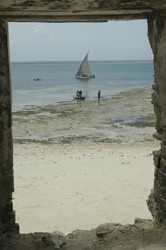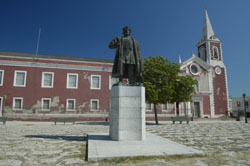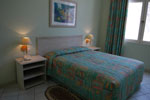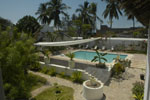Click
to search all
Mozambique Accommodation
|
Ilha de Moçambique
|
|
|
Mozambique Essential
|
Safari Guide & Accomodation Guide
![]() Kruger
South Africa
Kruger
South Africa
![]() Mozambique
Mozambique
![]() Zanzibar
Zanzibar
![]() Madagascar
Madagascar
![]() Namibia
Namibia
![]() Victoria
Falls
Victoria
Falls
![]() Botswana
Botswana
![]() South
Africa
South
Africa
![]() Cruises
Cruises
Ilha de Moçambique
The little island of Mozambique, which lies four kilometers off
the coast of Africa just opposite Madagascar, was for hundreds of
years a major center of intercontinental maritime trade. It was
occupied by Arab merchants from the tenth century until the end
of the fifteenth, and in the sixteenth century became a port of
call on the route from Europe to the East Indies opened by the Portuguese
navigator Vasco da Gama. In 1507, the Portuguese built a fortress
on the island where the Customs House stands today. |
 |
The town as it appears today has a strong architectural homogeneity
which is largely due to the use over the centuries of the same building
materials, mainly limestone from quarries in the south of the island.
and wood for beams and framework. |
|
|
|
|
Places to stay on Ilha de Mocambique Island
Hotel
Omuhipiti |
Escondidhno |
Also, a not to miss is The Chapel of Nossa Senhora de Baluarte (Capela
de Nossa Senhora do Baluarte in portuguese)which was build in 1522 and
is considered as the oldest European building in the southern hemisphere.
The chapel is situated at the northernmost point of the island, where
Vasco da Gamma built the first artillery bastion during his first journey
to India to defend the island against the Arabs.
The chapel is build in the Manuelino architecture, a building style during
the late Portuguese Middle Ages. There are several plaques of people who
have died on the island. There is also a wooden box with the human bones
in the side room. They're told to be of the Capitain of the Fort...
To get to the chapel, ask the guide who takes you around the fort to open
you the backdoor with the huge, old key.
You can also walk around the fort at low tide. The views are superb, but
pay attention to the incoming tide.
Construction of the fort (Fortaleza Sao Sebastiao) began in 1558. The building was finally completed 62 years later, in 1620 after it was interrupted by several Dutch attacks in 1607 and 1608. The fort was heavily guarded by a large number of canons and withstood attacks from Omani Arabs in 1670, English in 18th century and French in beginning of 19th century. Some of the canons are still in place and date from 1823 and 1824.There is also another church inside the fort, old hospital and underground drinking water cistern, which was until recently the only public resource of drinking water on the island.
The fort is open every day and local students will guide you through the fort. There's no entry, but you should pay the guide around 1U$.
The church dates back to 1535 and it is today run by House of Mercy, a Portuguese religious organization, which has operated also the old hospital, where is housed today the Museum of Sacred Art. The museum displays religious ornaments, carvings and paintings. Among numerous interesting pieces you can find also the statue of Santa Isabel, Queen of Portugal created in 17th century.
The museum is open from 8 am to noon and 2pm to 5 pm. Entry is free, but a donation or small tip for the guide is expected.
The imposing red building on the main square is the former governor's palace (Palacio de Sao Paulo). Built in 1674 as a jesuit convent in replacement of the Jesuit monastery, which was destroyed by Omani Arabs in 1670. The convent was modified into governor's palace in 1759, when the Jesuit were banned from Portugal and its colonies. The building served as governor (of Mozambique) palace until 1898, later as the residence of district governor and at the end as the oversees residence for Portuguese President and ministers.
The palace is today converted into museum displaying the furniture from Goa and India, ecquisite carpets, chinese porcelain, paintings and other pieces from the colonial period.
There is also a Maritime Museum in the basement with numerous exhibits from the boats which frequented the island including the small wooden boat from on of the Vasca da Gamma's vessels.
The museum a must for every island visitor. It's open from 8 am to noon and 2pm to 5 pm. Entry is free, but a donation or small tip for the guide is expected.
The elegant, green colored Mosque, which is overlooking the island's market is a tangible testimony of the growing presence of islamic community on the island. The Omani Arab traders have been present already in the 10th century on the island, pruning commerce with local Bantu tribes. With the arrival of Vasco da Gamma, Portuguese took over the island and the influence of islam vanished until the Mozambique's independence.
The present mosque was build a century ago. You can visit it except during prayer times. The view from the minaret over the stone town's roofs is exceptional.
Farmers and fishermen offer a variety of local fruits and seafood on the busy market in front of the mosque. Best time to go is in the early morning, when the dhows arrives from the mainland to bring the merchandise.
The Hindu Temple in the center of the town was build by the Indian community, very present in today's Mozambique. Indian traders have disembarked very soon on the island, following the trade routes opened by Vasco da Gamma in the 16th century.
The Temple can be visited outside of the praying time and the friendly staff will show you around. There's a pleasant garden behind the Temple.
The original fort was built in 1587 to protect the island's eastern inside from the attacks. The present fort was build in 1820 and the church in 1969 which has replaced the original one from the early 16th century.
The place in front of the church is used by the local fishermen as a port. You can observe going out on the sea and coming back with the fish. Fishing nets are being dried in the afternoon, giving the place a special colored view.
Capitania stands for Port Authority in Portuguese. The district of the Capitania reaches today still from Matibane to Qinga which gives an idea of former importance.
At the entry gate are two big canons from the 19th century and a 3 meters high anchor. Inside of the port you can see numerous steel wrecks of the former barge fleet to unload the trading boats anchoring in the safe harbor. Most of this wrecks were still in use before the Independence in 1975. In one of the workshops you can find the bronze statue of Vasco da Gama laying on the ground. He fall from his base on the Independence day 25 years ago and got there his place. The new Governor of the Province Nampula want to help poor Vasco back on his former place. Further one of the old Workshops turns into the base of a new underwater archaeological project on the Island.
Luís (Vaz) de Camões (1524 - 1580) was Portugal's great national poet, author of the epic poem Os Lusíadas (1572), which describes Vasco da Gama's discovery of the sea route to India. The statue was erected couple of years ago and faces the Indian ocean on the eastern side of the island. Just in front of Casa Branca guesthouse.
In the northern part of the town, the tribunal is an interesting colonial building from the end of the last century. It's still in use today.
Build in 1877 in neo-classical style (Schinken style), this was the biggest and best equipped hospital in Mozambique. Today, it still offers medical help but it suffers of lack of medicine and financing for maintenance of the buildings. The buildings stands on the site of the earlier convention of of San Joao de Deus, erected in 1681.
Diagonally across from the hospital, is the Church of Health (Igreja de Nostra Senhora da Saude). This catholic church was build in the middle of 16th century. It was restored in 1996.
Situated at the southern extremity of the island, the cemetery host some interesting testimonies of the islands past.
The old cinema and theatre is situated on the eastern side of the island, 5 minutes walk from the fort. There're unfortunately no shows today. There was a Ilha Miss Bikini show some time ago..
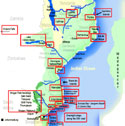
 Places to stay on Ilha de Moçambique
Places to stay on Ilha de Moçambique
 Pelican Air
Pelican Air 